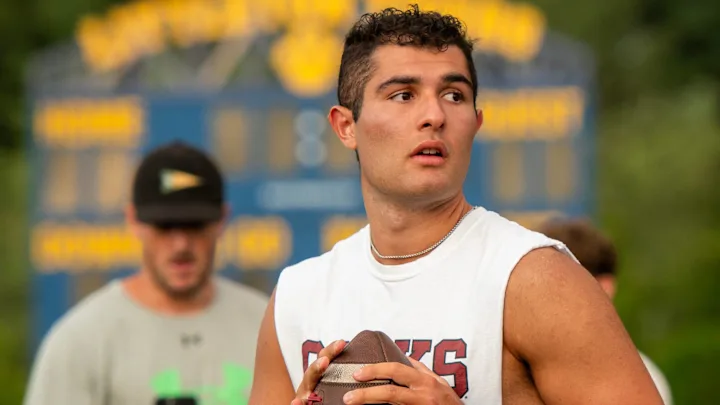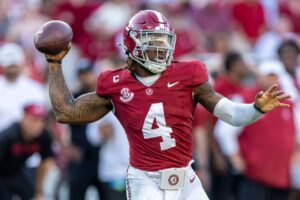
Gamecock Quarterback Room Thins as Dante Reno Seeks New Opportunity in Transfer Portal
In a move that adds another layer to the ever-evolving landscape of college football rosters, South Carolina redshirt freshman quarterback Dante Reno has officially entered the NCAA Transfer Portal. The announcement, made public on Thursday, April 24, 2025, signals the departure of a promising young talent who was once considered a key piece of the Gamecocks’ future under center. Reno’s decision comes after spending over a year and a half in Columbia, having enrolled in January 2024 following a distinguished high school career.
Reno arrived at South Carolina with considerable accolades, highlighted by his Under Armour All-American status earned at Cheshire Academy in Connecticut. During his true freshman season in 2024, he took a redshirt, primarily operating with the scout team to develop his skills and understanding of the college game. The recently concluded spring practice provided a glimpse into the quarterback competition, where Reno saw limited action in the spring game. The majority of snaps were distributed among veteran Luke Doty, true freshman Cutter Woods, and Ohio State transfer Air Noland, while starting quarterback LaNorris Sellers participated in a limited capacity during the spring’s final official practice.
The quarterback room at South Carolina has undergone significant transformation in recent times. LaNorris Sellers established himself as the clear starter in the 2024 season, leading the Gamecocks to a 9-3 record and generating considerable excitement for his potential. However, the depth behind him has been fluid. The program welcomed Air Noland, a highly touted transfer from Ohio State, adding immediate competition and talent to the quarterback ranks. Additionally, the arrival of true freshman Cutter Woods further bolstered the position group with a young, promising prospect. Veteran Luke Doty, who has experience at quarterback and even spent time at wide receiver, remained in the mix, providing versatility and leadership.
Given this crowded quarterback room, Reno’s decision to enter the transfer portal suggests a desire for a clearer path to playing time. With Sellers firmly entrenched as the starter and both Noland and Woods seemingly ahead in the pecking order based on spring game usage, Reno’s opportunities for significant snaps in the near future appeared limited. The transfer portal offers him a chance to find a program where he might have a greater likelihood of competing for a starting role and gaining valuable on-field experience.
Reno’s departure leaves South Carolina with four scholarship quarterbacks on their roster heading into the fall: the established starter LaNorris Sellers, highly regarded transfer Air Noland, promising freshman Cutter Woods, and experienced veteran Luke Doty. While the depth chart still appears solid, the loss of a player with Reno’s potential underscores the transient nature of college football rosters in the era of the transfer portal.
The NCAA transfer portal has become an increasingly influential factor in college football. Established in 2018, it provides a mechanism for student-athletes to inform other schools of their desire to transfer. Once a player officially enters their name into the portal through their current school’s compliance office, other institutions are permitted to contact them. Importantly, players have the option to withdraw their names from the portal and return to their original school, although the school is under no obligation to reinstate any athletic scholarship.
For undergraduate student-athletes, there are specific windows during which they can enter the transfer portal and maintain immediate eligibility at their next institution. For football, the spring transfer window typically runs for ten days in mid-April. Graduate students, however, have more flexibility and can enter the portal at any time. Players who enter the portal outside of these designated windows may be required to sit out a season at their new school, although there are exceptions to this rule.
The decision for a player to enter the transfer portal is often multifaceted. Playing time, coaching changes, scheme fit, and academic opportunities can all play significant roles. In Reno’s case, the influx of talent at the quarterback position at South Carolina likely contributed to his decision to seek an environment where he could see the field sooner.
Reno’s departure marks the second scholarship player to enter the transfer portal from South Carolina during the spring window, joining offensive lineman Kam Pringle. This movement highlights the ongoing roster management that college football programs must navigate, balancing player retention with the acquisition of new talent through both recruiting and the transfer portal.
As Dante Reno embarks on the next chapter of his football journey, he will carry with him the experience gained during his time at South Carolina. He will have four years of eligibility remaining at his new destination, providing ample opportunity to develop and showcase his skills. The Gamecocks, meanwhile, will move forward with their remaining quarterback corps, focused on the upcoming season and the development of their talented group. The transfer portal continues to reshape college football, and Reno’s move is a testament to its significant impact on team dynamics and individual player opportunities.





